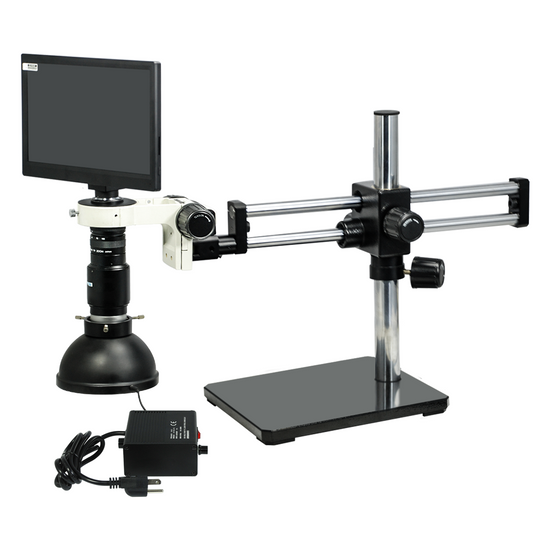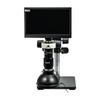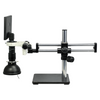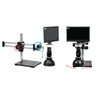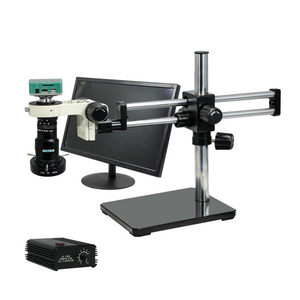Quick Overview
Infinite. Total Magnification: 1-6X. Zoom Ratio: 6:1. Body Mounting Size for Stand: Dia. 47mm. Dual Arm Stand. UV FREE LED Light. Light Adjustable. CMOS. 2.0 Megapixels. Windows XP/7/8/10/11. Screen Size: 11.6in. Input Voltage: DC 12V. Input Voltage: AC 96-265V 50/60Hz. ESD Safe. The optical system lens is provided by Navitar, and other accessories such as Stands, camera and light source are provided by our company.
MZ02110504 Video Zoom Microscope
Optical System Specifications
| Optical System | Infinite |
| System Optical Magnification | 1-6X |
| Total Magnification | 1-6X |
Video Monocular Zoom Body
| Navitar Zoom 7000 Macro Video Zoom Lens | |
| Body Optical System | Infinite |
| Body Magnification | 1-6X |
| Zoom Ratio | 6:1 |
| Zoom Operating Mode | With the Nosepiece |
| Body Mounting Size for Stand | Dia. 47mm |
| For Camera Sensor Size | Under 2/3 in. |
| Surface Treatment | Electroplating Black |
| Material | Metal |
| Color | Black |
| Net Weight | 0.58kg (1.28lbs) |
Dual Arm Stand
| Dual Arm Boom Stand | |
| Stand Type | Dual Arm Stand |
| Vertical Post Height | 384mm |
| Maximum Vertical Post Extended Length | 254mm |
| Vertical Post Diameter | Dia. 37.2mm |
| Cross Adapter Type | Triple (3) Hole Adapter |
| Horizontal Arm Type | Double Bar |
| Horizontal Arm Length | 570mm |
| Horizontal Diameter | Dia. 20mm |
| Mounting Hole on the Top of Horizontal Arm | 16mm |
| Horizontal Rotation Angle | 360° Degree Rotatable |
| Horizontal Arm Travel Distance on Z-Axis | 282mm |
| Horizontal Arm Stretch Range | 320mm (12.598 in. ) |
| Horizontal Arm Maximum Load | 9.50kg (20.94lbs) |
| Horizontal Arm Travel Mode on Horizontal Direction | Ball Bearing |
| Horizontal Arm Travel Mode on Z Direction | Manual |
| Base Type | Heavy Duty Base |
| Base Shape | Rectangle |
| Base Dimensions | 285x260x18mm |
| Surface Treatment | Electroplating Black |
| Material | Metal |
| Color | Black |
| Net Weight | 18.06kg (39.82lbs) |
| Dimensions | 570x285x405mm (22.441x11.220x15.945 in. ) |
E-Arm
| 76mm E-Arm | |
| Holder Adapter Type | Dia. 76mm Scope Holder |
| Focus Distance | 50mm |
| Coarse Focus Distance per Rotation | 20mm |
| E-Arm Rotation Range on Horizontal Direction | 360° |
| E-Arm Rotation Range on Z Direction | 180° |
| E-Arm Mounting Adapter | 5/8 in. End Adapter |
| Center Distance from E-Arm Adapter to Scope Holder | 130mm |
| E-Arm Horizontal Adjustment Screw | Horizontal Adjustable |
| Safety Protection Against Falling Screw | With Safety protection against falling Screw |
| Surface Treatment | Spray Paint |
| Material | Metal |
| Color | White |
| Net Weight | 0.84kg (1.85lbs) |
Donut Adapter
| 47/76mm Donut | |
| Donut Adapter Type | Scope Mounting Converter |
| Donut Adapter Size for Scope Mounting | Dia. 47mm |
| Donut Adapter Size for Scope Holder | Dia. 76mm |
| Donut Adapter Height | 20mm |
| Surface Treatment | Electroplating Black |
| Material | Metal |
| Color | Black |
| Net Weight | 0.18kg (0.40lbs) |
| Applied Field | For Navitar Zoom Series Lens |
Diffuse Light
| UV Free LED Diffuse Illuminator (6W ID60mm 120Bulbs) | |
| Light Source Type | UV FREE LED Light |
| Ring I.D. Size | Dia. 60mm |
| LED Quantity | 120 |
| Power Supply Adjustable | Light Adjustable |
| Power Box Panel Meter Display | Pointer Panel Meter/Scale |
| Power Box Cooling System | Heat Sink |
| Power Box Dimensions | 100x110x50mm |
| Bulb Color (Wavelength) | UV FREE |
| Output Power | 6W |
| Input Voltage | AC 96-265V 50/60Hz |
| Output Voltage | DC 24V |
| Power Cord Connector Type | USA 3 Pins |
| Power Cable Length | 1.3m |
| Surface Treatment | Spray Paint |
| ESD Safe | ESD Safe |
| Material | Metal |
| Color | Black |
| Net Weight | 0.98kg (2.16lbs) |
| Screw Model | M4x12mm |
LCD Display Digital Camera
| 11.6 in. LCD Display Digital Camera | |
| Image Sensor | CMOS |
| Image Sensor Size | 1/2.86 in. |
| Image Sensor Diagonal size | 6.592mm (0.260 in. ) |
| Camera Maximum Pixels | 2.0 Megapixels |
| Camera Resolution | 1920x1080 |
| Camera Lens Mount | CS-Mount |
| Transmission Frame Rate | 36fps |
| White Balance | Manual/Auto |
| Gain Control | Adjustable |
| Exposure Control | Manual/Auto |
| Camera Crosshairs | Cross Line |
| Number of Crosshairs | 4 Movable Crosshairs |
| Line Color | User Defined |
| Capture Function | Yes |
| Image Capture Output Format | TIFF/JPG/BMP/PNG |
| Video Output Format | MP4 |
| System Requirement | Windows XP/7/8/10/11 |
| Driver Installation | Driver free |
| Camera Housing Material | Plastic |
| Camera Housing Size | 40x40x58mm |
| Camera Housing Color | Black |
| Max. Supported Memory Card | 32G |
| Screen Size | 11.6in |
| Screen Aspect Ratio | 16:9 |
| Monitor Signal Format | NTSC/PAL Auto-Switch |
| Monitor Max. Resolution | 1920x1080 |
| Input Voltage | DC 12V |
| Net Weight | 0.65kg (1.43lbs) |
| Dimensions | 280x200x55mm (11.024x7.874x2.165 in. ) |
Camera Accessories
| 11.6 in. LCD Display Digital Camera | |
| C/CS Spacer | 5mm |
| Mouse Operation | Yes |
| Memory Type | SD |
| Memory Capacity | 4G |
Other Parameters
| Notes | The optical system lens is provided by Navitar, and other accessories such as Stands, camera and light source are provided by our company |
Technical Info
Instructions
Video Zoom LensClose Λ
| Video zoom lens, refers to microscope that has only one set of imaging optical paths. It can be considered as a set of dual optical path stereo microscopes. The magnification and multiple range of video zoom lens are usually the same as those of a stereo microscope, but because the objective lens is one, its optical imaging is flat, not stereoscopic. It has been observed that as most of the parametric features are close to stereo microscopes, video zoom lens is then classified as stereo microscope. In fact, it lacks the most important "stereoscopic" imaging features. Compared with other compound microscopes such as biological metallurgical microscopes, the total optical magnification of video zoom lens is generally below 40X, which is the coverage of low magnification range that these microscopes do not have. Most of the video continuous zoom lens is to observe the electronic image, not through the eyepiece, but through the camera. Video zoom lens can have relatively more objective lens and photographic eyepiece multiples for selection. At the same time, video zoom lens can also be designed as parallel light so as to add even more configuration accessories, such as observation eyepieces, aperture diaphragms, coaxial illumination light sources, reticles, and nosepieces that can change the viewing angle and direction, etc. Regarding accessories of video zoom lens such as the stands and light source etc., generally, all accessories of stereo microscope can be used. Therefore, video zoom lens combination is flexible, compact, with strong adaptability and low cost, suitable for use in industry, especially extensively used in the electronics industry. |
InfiniteClose Λ
| Microscopes and components have two types of optical path design structures. One type is finite optical structural design, in which light passing through the objective lens is directed at the intermediate image plane (located in the front focal plane of the eyepiece) and converges at that point. The finite structure is an integrated design, with a compact structure, and it is a kind of economical microscope. Another type is infinite optical structural design, in which the light between the tube lens after passing the objective lens becomes "parallel light". Within this distance, various kinds of optical components necessary such as beam splitters or optical filters call be added, and at the same time, this kind of design has better imaging results. As the design is modular, it is also called modular microscope. The modular structure facilitates the addition of different imaging and lighting accessories in the middle of the system as required. The main components of infinite and finite, especially objective lens, are usually not interchangeable for use, and even if they can be imaged, the image quality will also have some defects. The separative two-objective lens structure of the dual-light path of stereo microscope (SZ/FS microscope) is also known as Greenough. Parallel optical microscope uses a parallel structure (PZ microscope), which is different from the separative two-object lens structure, and because its objective lens is one and the same, it is therefore also known as the CMO common main objective. |
System Optical MagnificationClose Λ
| The magnification of the objective lens refers to the lateral magnification, it is the ratio of the image to the real size after the original image is magnified by the instrument. This multiple refers to the length or width of the magnified object. System optical magnification is the product of the eyepiece and the objective lens (objective lens zoom set) of the optical imaging part within the system. Optical magnification = eyepiece multiple X objective lens/objective lens set The maximum optical magnification of the microscope depends on the wavelength of the light to which the object is illuminated. The size of the object that can be observed must be greater than the wavelength of the light. Otherwise, the light cannot be reflected or transmitted, or recognized by the human eye. The shortest wavelength of ultraviolet light is 0.2 microns, so the resolution of the optical microscope in the visible range does not exceed 0.2 microns, or 200 nanometers. This size is converted to the magnification of the microscope, and it is the optical magnification of 2000X. Usually, the compound microscope can achieve 100X objective lens, the eyepiece is 20X, and the magnification can reach 2000X. If it is bigger, it will be called "invalid magnification", that is, the image is large, but the resolution is no longer increased, and no more details and information can be seen. |
Total MagnificationClose Λ
| Total magnification is the magnification of the observed object finally obtained by the instrument. This magnification is often the product of the optical magnification and the electronic magnification. When it is only optically magnified, the total magnification will be the optical magnification. Total magnification = optical magnification X electronic magnification Total magnification = (objective X photo eyepiece) X (display size / camera sensor target ) |
Video Monocular Zoom BodyClose Λ
| Video monocular zoom body is a zoom body that has only one set of optical paths, and it is also the body of the video continuous zoom. The upper end of the microscope body can be connected to the standard C-interface photo eyepiece, and then connected to the microscope camera; the lower end is the objective lens, and the objective lens of parallel structure is generally separated from the body, whereas the microscope body of finite structure is combined with the objective lens. Some bodies of microscope have also a light source coaxial illumination device. |
Zoom RatioClose Λ
| Zoom ratio is the ratio of the maximum magnification / the minimum magnification. Expressed as 1: (ratio of maximum magnification / minimum magnification). If the maximum magnification is 4.5X, the minimum magnification is 0.7X, then the zoom ratio = 4.5 / 0.7 = 6.4, the zoom ratio will be 1:6.4. Zoom ratio is obtained by the intermediate magnification group of the microscope. When the magnification is increased or decreased by using other objective lenses, the zoom ratio does not change accordingly. |
With the NosepieceClose Λ
| When the microscope body changes the magnification, it is realized by adjusting the zoom drum or nosepiece. Generally, the lower case of the microscope is used as the zoom drum or nosepiece. When magnification conversion is required, it can be realized by turning the zoom drum or nosepiece. |
For Camera Sensor SizeClose Λ
| For the size of the lens field of view of the coupler/C-mount-adapter, in the design process, the size of the camera sensor imaging target should be considered. When the field of view of the lens is smaller than the target plane of the camera, “black border” and “dark corner” will appear. The general microscope coupler/C-mount adapters are generally designed for the 1/2" camera targets. When a camera of 2/3 or larger target is used, the “dark corner” phenomenon will appear in the field of view. Especially, at present, DSLR cameras generally use large target plane design (1 inch full field of view), when used for microscopic photographing, the general DSLR camera coupler/C-mount adapter will have “black border”. Generally, the “dark corner” that appears on the field of view is often that the center of the microscope and the camera are not aligned. Adjust the position of the screw on the camera adapter, or turn the camera adapter to adjust or change the effect. |
Dual Arm StandClose Λ
| Dual arm stand is also called double bar stand, or ball bearing boom stand. The method of use of dual arm stand and most of its parameters are mostly the same as that of the boom stand. The difference is that the cross arm has two rods, and is held by one set of bearings, so that the two cross arms can be freely pulled and moved, and they are vertical and cannot be tilted left and right, making it more free and stable than the use of the dual arm stand in the horizontal direction. It is especially suitable for users who need to frequently push and pull, observe and adjust the position in horizontal direction. |
360° Degree RotatableClose Λ
| The eyepiece of the microscope can have different viewing or observing directions. When the position of the microscope is uncomfortable, the direction of the eyepiece tube of the microscope can be adjusted, to facilitate observation and operation. Placement method of different viewing angles of the microscope: General direction: the support column is behind the object to be observed Reverse direction: the support column is in front of the object to be observed Lateral direction: the support column is on the side of the object to be observed Rotating eyepiece tube, different microscopes may have different methods, for some, the direction is confirmed when installing the eyepiece tube of the microscope, for some, by rotating the body of the microscope, and for some, by rotating the support member on the support or holder of the microscope. |
E-ArmClose Λ
| Usually the universal joint is called E-Arm, i.e., Easy-Arm, also known as Universal Arm. Many people in the industry call it Bonder Arm, which refers to the components that connect the microscope on the COG Bonding Machine. At the tail of the E-arm there is a standard 5/8 inch (0.625 inch, 15.875mm) connector. The connector can be moved freely in both horizontal and vertical directions, and can also be fixed at an angular position in the vertical direction to facilitate microscope observation from different angles. E-arm can be connected to various kinds of microscope stands with 5/8-inch adapters, such as boom stand, flexible arm etc. It is also possible to connect various kinds of microscopes by adding or replacing different adapters. Note that, in general, these stands themselves are not directly configured with this E-arm, and separate purchase is necessary. |
Dia. 76mm Scope HolderClose Λ
| The 76mm stand scope holder is the most popular microscope body adapter size, suitable for stereo microscopes produced by most manufacturers. Place the microscope body in a 76mm scope holder, tighten with screws to avoid shaking when the microscope is in use. Because this stand scope holder is very common, some special-sized microscopes can also borrow and use this stand, but only need a specific adapter to connect the microscope body with a diameter of less than 76mm. |
Donut AdapterClose Λ
| Donut adapter is an adapter used to convert the scope holder of the microscope and the size of the microscope body. For different manufacturers and different types of microscopes, as well as different stands, their adapters are often different and not interchangeable. This type of donut adapter can be used to connect different microscope stands and microscope bodies, which is very convenient for interchange of different manufacturers and microscope models. It is usually to use this adapter cable to fix it to the body of the microscope, which is equivalent to changing the fixed diameter of the microscope, and then placing it on the microscope stand. |
Diffuse LightClose Λ
| Diffuse reflection is a phenomenon in which light projected on a rough surface or an irregular medium is reflected in all directions of space. When a parallel incident light hits a rough surface, the surface reflects the light in all directions, and therefore, even though the incident rays are parallel to each other, but because of the inconsistency of the normal directions of the various points, the reflected rays are irregularly reflected in different directions. This reflection is called "diffuse reflection" or "diffuse", but the frequency of the starting light does not change. In microscope illumination, diffuse light can provide highly uniform, flat, shadowless light. For objects with high reflectivity, such as spherical bodies, multi-faceted crystals, sharp and reflective objects, specular reflection objects, etc., diffuse light can eliminate reflections from objects and improve image quality. The disadvantage of diffuse light is that they are relatively large in size, and must be larger than the object being observed. The position of the illumination is relatively low, occupying a larger working space, sacrificing the working distance between the microscope and the object to be observed, which causes inconvenience to the operation under the microscope. However, for conventional inspection observation and measurement works, it is not affected. |
Light AdjustableClose Λ
| The brightness of the light source adjustable is very important in the imaging of the microscope. Since the difference of the numerical aperture of the objective lens of high magnification and low magnification is very big, more incident light is needed to achieve a much better resolution when using a high magnification objective lens. Therefore, when observing through a high magnification objective lens, the brightness required is high; when observing through a low magnification objective lens, the brightness required is low. When observing different objects, or feature points of the same object at different positions, the brightness needs are also different; including the difference of background light or reflection within the field of view of observation, it has a great influence on the effect of observing the object, and therefore one needs to adjust the brightness of the light source according to each object to be observed. In the light source capable of providing continuous spectrum, such as a halogen lamp, the brightness adjustment of the light not only adjusts the brightness and intensity of the light, but also changes the spectrum emitted by the light source. When the light source is dark, there are many components of red light, and when the brightness is high, there are more blue spectrum. If the required light is strong and the spectrum needs to be changed, the light can be kept at a brighter intensity, which is solved by adjusting the spectrum by adding a color filter. Take note of the dimming button on the light source, after the On/Off switch is turned on, normally clockwise is to brighten, and counterclockwise is to darken. If it is adjusted to the lowest brightness, the light source should normally be lit. If the naked eye still can't see the object being illuminated brightly, you need to adjust the brightness knob to a much bigger position. Generally, there is scale marking on the dimming knob, which is an imaginary number representing the percentage of brightness, or an electronic digital display, giving the brightness of the light source under the same conditions a marking. |
ESD SafeClose Λ
| Static electricity is a charge that is at static or non-flowing state, and static electricity is formed when charges accumulate on an object or surface. Static electricity can cause malfunction or mis-opeartion of electronic equipment, resulting in electromagnetic interference. In the electronics industry, static electricity can break down integrated circuits and precision electronic components, causing components to age, and can also absorb dust, causing contamination of integrated circuits and semiconductor components, and reducing production yield. In the plastics industry, static electricity can cause film or membrane not wining up uniformly, film and CD plastic discs contaminated with dust, thereby affecting quality. In industrial production, especially in electronic production and processing and inflammable and explosive production sites, electrostatic protection should be taken seriously. ESD means "electro-static discharge." For the methods of ESD treatment with respect to microscope and components, electrical conductivity of the metal should be utilized on the one hand, and on the other hand, electrostatic materials, electrostatic coating and other methods of treatment should be adopted to solve the electrostatic problem. Electrostatic coating is to apply coat that can prevent static electricity. It has electrostatic discharge, dust-proof, mildew-proof, wear-resistant, acid and alkali resistance and other characteristics. The surface of the coating does not generate static electricity or the static electricity is discharged to the safe place through the conductor row. On some components, electrostatic materials may be applied, such as the microscope knob handle, insulation mat, septum, microscope cover etc. |
LCD Display Digital CameraClose Λ
| LCD display digital camera is a combination of a digital camera and a display. |
CMOSClose Λ
| CMOS, or complementary metal oxide semiconductor. Both CMOS and CCD sensors have their own respective advantages and disadvantages. As a kind of photoelectric conversion sensor, among the current cameras, CMOS is relatively more widely used. |
Image Sensor SizeClose Λ
| The size of the CCD and CMOS image sensors is the size of the photosensitive device. The larger the area of the photosensitive device, the larger the CCD/CMOS area; the more photons are captured, the better the photographic performance; the higher the signal-to-noise ratio, the larger the photosensitive area, and the better the imaging effect. The size of the image sensor needs to match the size of the microscope's photographic eyepiece; otherwise, black borders or dark corners will appear within the field of view of observation. |
Camera Maximum PixelsClose Λ
| The pixel is determined by the number of photosensitive elements on the photoelectric sensor of the camera, and one photosensitive element corresponds to one pixel. Therefore, the more photosensitive elements, the larger the number of pixels; the better the imaging quality of the camera, and the higher the corresponding cost. The pixel unit is one, for example, 1.3 million pixels means 1.3 million pixels points, expressed as 1.3MP (Megapixels). |
Camera ResolutionClose Λ
| Resolution of the camera refers to the number of pixels accommodated within unit area of the image sensor of the camera. Image resolution is not represented by area, but by the number of pixels accommodated within the unit length of the rectangular side. The unit of length is generally represented by inch. |
Camera Lens MountClose Λ
| Industrial camera adapters are usually available in three types: 1. C-Mount: 1" diameter with 32 threads per inch, flange back intercept 17.5mm. 2. CS-Mount: 1" diameter with 32 threads per inch, flange back intercept 12.5mm. CS-Mount can be converted to a C-Mount through a 5mm spacer, C-mount industrial camera cannot use the CS-mount lens. 3. F-Mount: F-mount is the adapter standard of Nikon lens, also known as Nikon mouth, usually used on large-sized sensor cameras, the flange back intercept is 46.5mm. |
Transmission Frame RateClose Λ
| Frame rate is the number of output of frames per second, FPS or Hertz for short. The number of frames per second (fps) or frame rate represents the number of times the graphics process is updated per second. Due to the physiological structure of the human eye, when the frame rate of the picture is higher than 16fps, it is considered to be coherent, and high frame rate can make the image frame more smooth and realistic. Some industrial inspection camera applications also require a much higher frame rate to meet certain specific needs. The higher the resolution of the camera, the lower the frame rate. Therefore, this should be taken into consideration during their selection. When needing to take static or still images, you often need a large resolution. When needing to operate under the microscope, or shooting dynamic images, frame rate should be first considered. In order to solve this problem, the general industrial camera design is to display the maximum frame rate and relatively smaller resolution when viewing; when shooting, the maximum resolution should be used; and some cameras need to set in advance different shooting resolutions when taking pictures, so as to achieve the best results. |
White BalanceClose Λ
| White balance is an indicator that describes the precision of white color generated in the image when the three primary colors of red, green and blue are mixed, which accurately reflects the color condition of the subject. There are manual white balance and automatic white balance. White balance of the camera is to "restore white objects to white color under any light source." The chromatic aberration phenomenon occurred under different light sources is compensated by enhancing the corresponding complementary color. Automatic white balance can generally be used, but under certain conditions if the hue is not ideal, options of other white balance may be selected. |
Camera CrosshairsClose Λ
| Camera crosshairs refers to the preset reference line within the camera, which is used to calibrate various positions on the display. The most commonly used is the crosshair, which is to determine the center position of the camera image, and it is very important in measurement. Some cameras also have multiple crosshairs that can be moved to quickly detect and calibrate the size of the object being viewed. Some crosshairs can also change color to adapt to different viewing backgrounds. |
PackagingClose Λ
| After unpacking, carefully inspect the various random accessories and parts in the package to avoid omissions. In order to save space and ensure safety of components, some components will be placed outside the inner packaging box, so be careful of their inspection. For special packaging, it is generally after opening the box, all packaging boxes, protective foam, plastic bags should be kept for a period of time. If there is a problem during the return period, you can return or exchange the original. After the return period (usually 10-30 days, according to the manufacturer’s Instruction of Terms of Service), these packaging boxes may be disposed of if there is no problem. |
Optical Data
| Camera Image Sensor Specifications | |||
| No. | Camera Image Sensor Size | Camera image Sensor Diagonal | |
| (mm) | (inch) | ||
| 1 | 1/4 in. | 4mm | 0.157" |
| 2 | 1/3 in. | 6mm | 0.236" |
| 3 | 1/2.8 in. | 6.592mm | 0.260" |
| 4 | 1/2.86 in. | 6.592mm | 0.260" |
| 5 | 1/2.7 in. | 6.718mm | 0.264" |
| 6 | 1/2.5 in. | 7.182mm | 0.283" |
| 7 | 1/2.3 in. | 7.7mm | 0.303" |
| 8 | 1/2.33 in. | 7.7mm | 0.303" |
| 9 | 1/2 in. | 8mm | 0.315" |
| 10 | 1/1.9 in. | 8.933mm | 0.352" |
| 11 | 1/1.8 in. | 8.933mm | 0.352" |
| 12 | 1/1.7 in. | 9.5mm | 0.374" |
| 13 | 2/3 in. | 11mm | 0.433" |
| 14 | 1/1.2 in. | 12.778mm | 0.503" |
| 15 | 1 in. | 16mm | 0.629" |
| 16 | 1/1.1 in. | 17.475mm | 0.688" |
| Digital Magnification Data Sheet | ||
| Image Sensor Size | Image Sensor Diagonal size | Monitor |
| Screen Size (11.6in) | ||
| Digital Zoom Function | ||
| 1/2.86 in. | 6.592mm | 44.7 |
| 1. Digital Zoom Function= (Screen Size * 25.4) / Image Sensor Diagonal size | ||
| Contains | ||||||||||||||||||||||
| Parts Including | ||||||||||||||||||||||
| ||||||||||||||||||||||
| Packing | |
| Packaging Type | Carton Packaging |
| Packaging Material | Corrugated Carton |
| Packaging Dimensions(1) | 51x43x18cm (20x17x7″) |
| Packaging Dimensions(2) | 21x8.5x9cm (8.268x3.346x3.543″) |
| Packaging Dimensions(3) | 10.5x5.5x13cm (4.133x2.165x5.118″) |
| Packaging Dimensions(4) | 29x16x18cm (11.417x6.299x7.087″) |
| Packaging Dimensions(5) | 33x24.5x9cm (12.992x9.646x3.543″) |
| Packaging Dimensions(6) | 21.5x21.5x21cm (8.464x8.464x8.267″) |
| Inner Packing Material | Plastic Bag |
| Ancillary Packaging Materials | Expanded Polystyrene |
| Gross Weight | 19.58kg (43.17lbs) |
| Minimum Packaging Quantity | 1pc |
| Transportation Carton | Carton Packaging |
| Transportation Carton Material | Corrugated Carton |
| Transportation Carton Dimensions(1) | 51x43x18cm (20x17x7″) |
| Transportation Carton Dimensions(2) | 21x8.5x9cm (9x4x4″) |
| Transportation Carton Dimensions(3) | 15.2x15.2x15.2cm (6x6x6″) |
| Transportation Carton Dimensions(4) | 29x16x18cm (11.417x6.299x7.087″) |
| Transportation Carton Dimensions(5) | 33x24.5x9cm (12.992x9.646x3.543″) |
| Transportation Carton Dimensions(6) | 21.5x21.5x21cm (9x9x9″) |
| Total Gross Weight of Transportation(kilogram) | 24.00 |
| Total Gross Weight of Transportation(pound) | 52.93 |
| Quantity of One Transportation Carton | 6pc |






